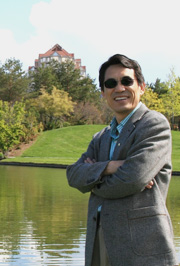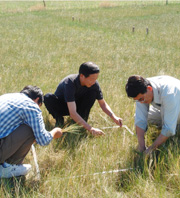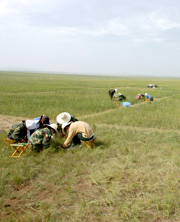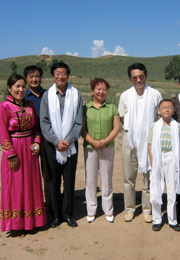
|
|
September 30, 2011
Dear Board Member,
|
| |
|
Thank you to all who participated in the Board meeting this week. We value your insights and will follow up shortly with meeting minutes and details of future meetings and events for everyone. In the meantime, please review this month’s briefing on recent news and activities in sustainability. On page two, we introduce Dr. Jianguo Wu, a recognized international leader in grasslands and urban ecology.
|
| |
|
Highlights of ASU sustainability activities
|
| |
- ASU’s strategy to reduce its carbon footprint has hit an important milestone. In September, the university reached 10 megawatts of total solar energy capacity – the first university in the U.S. to do so. Solar installations operate at two of ASU’s four campuses thus far, providing about 20 percent of ASU’s peak load and reducing carbon emissions up to 10 percent. ASU’s goal is to reach a university-wide total of 20 megawatts by 2014.
Read more »
|
| |
- NBC, National Science Foundation, and Discover magazine, in partnership with ASU, recorded a “Changing Planet” town hall panel discussion on the Tempe campus addressing climate change and sustainable water supplies. The event featured Bill Richardson, former governor of New Mexico; Grady Gammage Jr., Senior Sustainability Scholar with the Global Institute of Sustainability; Pat Mulroy, general manager of the Southern Nevada Water Authority; and Heidi Cullen, host of Forecast Earth and research scientist with Climate Central. The event will be broadcast on the Weather Channel in November and appear in Discover magazine.
Read more »
|
| |
- The International Water Association, a global network for water researchers and practitioners, has named Distinguished Sustainability Scientist Bruce Rittmann a 2011 Fellow, the organization’s most prestigious professional honor. Rittmann, who is director of the Biodesign Institute’s Swette Center for Environmental Biotechnology, is widely recognized as an international leader in applying microbes to solve health, energy, and environmental problems. Among his achievements is a membrane biofilm reactor that uses naturally occurring microorganisms to remove industrial contaminants from water.
Read more »
|
| |
- A total of 65 School of Sustainability students studied abroad during the 2010-11 school year, gaining firsthand insights into diverse cultures and interconnected sustainability issues spanning six continents. Among the programs attracting the most students were Human Dimensions of Sustainability in Australia, Urban Sustainability and Planning in Thailand, Culture and Sustainability in Dubai, Global Resolve in Ghana, and Semester at Sea.
Read more »
|
| |
- China’s Sun Yat-Sen University and ASU have formalized a research collaboration to advance early and predictive diagnostics for colorectal cancer, the second leading cancer killer in the U.S. The program is led by Nobel Laureate and Distinguished Sustainability Scientist Lee Hartwell, who is also chief scientist at the Biodesign Institute’s Center for Sustainable Health. The alliance with Sun Yat-Sen University creates a second global hub for the Global Biosignatures Network, an ASU effort to harness resources from research, academia, and industry to vastly improve healthcare practice. Taiwan’s Chang Gung University is a founding member of the network.
Read more »
|
| |
|
Please feel free to email or call us with any questions or comments about this briefing.
Best regards,
|
| |
|
| |
�
Q&A With Dr. Jianguo Wu
Creating resilient landscapes:
From urban places to the grasslands of Genghis Khan
|
|
Jianguo Wu is a Senior Sustainability Scientist in the Global Institute of Sustainability, a professor in the School of Sustainability, and a Dean’s Distinguished Professor of Landscape Ecology and Sustainability Science in the School of Life Sciences, College of Liberal Arts and Sciences. He is known internationally for his research and teaching in the fields of landscape and urban ecology and as editor-in-chief of the interdisciplinary journal, Landscape Ecology. Wu has been honored with the 2011 Outstanding Scientific Achievements Award from the International Association for Landscape Ecology, the 2010 Distinguished Landscape Ecologist Award from the U.S. Association for Landscape Ecology, and the 2006 Award for International Scientific Cooperation from the American Association for the Advancement of Science.
|
|
What focused your research on sustainability?
As an ecologist by training, I have been concerned with the sustainability of local and world ecosystems since my college years. A more comprehensive understanding of sustainability – as a term that encompasses environmental, economic, and social dimensions – began to take shape in my mind after reading the 1999 National Research Council’s report, “Our Common Journey: A Transition Toward Sustainability,” and the seminal paper, “Sustainability Science,” published in 2001 in the journal, Science. My involvement with ASU’s sustainability-related initiatives since 2003 and with the journal, Landscape Ecology, since 2005 have helped me focus my research and teaching increasingly on sustainability-related topics.
|
|
What are your most important research projects?
My research group is currently conducting two lines of sustainability-related research. First, we have been working in the Inner Mongolia grassland, addressing research questions ranging from biodiversity to ecosystem services and sustainability. As part of this effort, we have established the world’s largest grassland field experiment to test functioning relationships between biodiversity and the ecosystem. Our ultimate goal is to understand the dynamics of the human-environment relationship on the Mongolian Plateau and seek solutions for sustainable development. Our fundamental question for this work: Is this the end of nomadism on the land of Genghis Khan?
Second, we are studying the ecology and sustainability of urban areas, particularly focusing on several cities in China and the Phoenix metropolitan region. This work quantifies the spatial and temporal patterns of urbanization, identifies its underlying drivers, and evaluates its environmental impacts. A major goal here is to integrate urban ecology and landscape ecology so as to produce “actionable knowledge” for urban sustainability.
|
|
How can your sustainability-related research affect future policy decisions?
As urbanization continues, our ecosystems and landscapes will be increasingly “domesticated” or “artificialized,” and our future will increasingly depend on our ability to protect and design nature. Our work in Inner Mongolia has attracted the attention of regional decision makers searching for sustainable development strategies. Our findings on urban ecology will inform policies to promote urban sustainability.
|
|
What world sustainability challenges concern you most?
Land use and land cover change is the most important cause of biodiversity loss and ecosystem degradation worldwide, especially when it comes through urbanization. Climate change also poses a serious sustainability challenge. A top priority for sustainability research and practice should be to integrate science and policies so we create resilient landscapes that can adapt to disturbances and climate change.
|
|
|

Dr. Jianguo (Jingle) Wu
|

Ecologists from ASU and the Chinese Academy of Sciences sample plant diversity in Inner Mongolia.
|

International graduate students and researchers participate in the world’s largest grassland field experiment.
|

Researchers are greeted by local dignitaries in Inner Mongolia.
|
|
|







